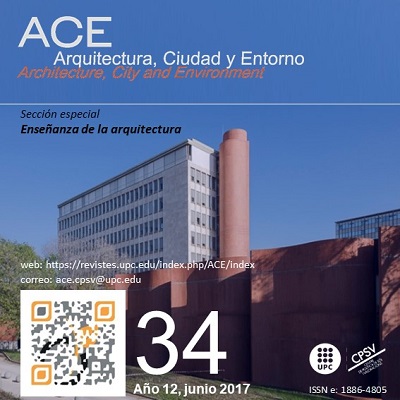El papel del dibujo y materias básicas frente nuevas herramientas para manipular el espacio. Casos de estudio de investigación educativa en docencia arquitectónica
DOI:
https://doi.org/10.5821/ace.12.34.5291Palabras clave:
Representación arquitectónica, TIC aplicadas a la enseñanza, tecnologías de diseño virtual 3DResumen
El objetivo de este trabajo es mostrar los resultados parciales de una investigación educativa sobre el desarrollo y la mejora de las capacidades espaciales y gráficas para representar operativamente el espacio arquitectónico, así como el rendimiento académico de los estudiantes de arquitectura a lo largo de toda su formación, usando herramientas gráficas más nuevas o las más tradicionales.
Para ello se han llevado a cabo estudios de caso usando estudiado grupos de control de alumnos de la Escola Tècnica Superior d’Arquitectura de Barcelona –ETSAB-, que usan técnicas y metodologías tradicionales y otros que usan las experimentales y aquellos que en algún momento del proceso docente incorporan prácticas que implican el uso de nuevas metodologías con ayuda de las técnicas informáticas.
Las escasas referencias bibliográficas en ensayos equiparables a éste en el ámbito de la arquitectura, que ofrezcan orientaciones dirigidas a los docentes e investigadores del área de la Expresión Gráfica Arquitectónica, avalan la pertinencia de nuestra aportación.
La falta de capacitación y afinidad –tanto como el desconocimiento- del dibujo tradicional a mano alzada por parte de los estudiantes que acceden a los estudios de arquitectura en España no puede ser compensada totalmente a lo largo estos, Por otra parte, sería absurdo no partir de su evidentemente sólida cultura visual que facilita la integración adecuada de las TIC al proceso formativo y lo requiere, aun cuando sólo fuera como estrategia de motivación. Si bien debería exigirse una mayor capacitación previa en dibujo tradicional para el acceso a la carrera, también se debería asumir una y una integración natural adecuada de todas las tecnografías en los diversos cursos, incluidas las materias proyectuales para adecuar las prácticas gráficas, optimizar los tiempos y el rendimiento académico.
Publicado
Número
Sección
Licencia
COPYRIGHT
El contenido de los artículos y los comentarios en ellos expresados son responsabilidad exclusiva de sus autores, y no reflejan necesariamente la opinión del comité editor de la revista. Los trabajos publicados por ACE pueden reproducirse bajo la licencia CC-BY-NC-ND 3.0 ES más información http://creativecommons.org/licenses/by-nc-nd/3.0/es/
Lo que implica que las personas autoras sólo retienen y mantienen los derechos de Copyright dentro de las limitaciones incluidas en la licencia anterior.





































